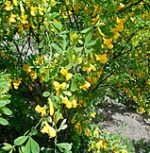 Native to Turkestan and Siberia, this deciduous suckering shrub is a member of the pea family, Fabaceae, that also includes beans, lupines and mimosa. It grows 6-10′ tall and forms clumps of slender supple branched stems that are gray green turning yellowish gray to brown with age. The dull green pinnate leaves are divided into 2-4 oval leaftlets that are up to 1″ long. From mid- to late spring bright yellow flowers appear either singly or in clusters of 2-3. They are 1″ long, pea-shaped and give way to cylindrical seeds pods 1.5″ long. Plants are tolerant of drought, alkaline soil, salt, and wind and are a good hedge plants for a xeriscape, erosion control, windbreaks and snow traps. The genus name, Caragana, is the Latinized version of the Mongolian name for the plant. The specific epithet, frutex, is the Latin word meaning shrub.
Native to Turkestan and Siberia, this deciduous suckering shrub is a member of the pea family, Fabaceae, that also includes beans, lupines and mimosa. It grows 6-10′ tall and forms clumps of slender supple branched stems that are gray green turning yellowish gray to brown with age. The dull green pinnate leaves are divided into 2-4 oval leaftlets that are up to 1″ long. From mid- to late spring bright yellow flowers appear either singly or in clusters of 2-3. They are 1″ long, pea-shaped and give way to cylindrical seeds pods 1.5″ long. Plants are tolerant of drought, alkaline soil, salt, and wind and are a good hedge plants for a xeriscape, erosion control, windbreaks and snow traps. The genus name, Caragana, is the Latinized version of the Mongolian name for the plant. The specific epithet, frutex, is the Latin word meaning shrub.
Type: Deciduous flowering shrub
Outstanding Feature: Flowers
Form: Rounded
Growth Rate: Rapid to moderate
Bloom: Clusters of bright yellow 1″ pea-like flowers from mid to late spring
Size: 6-10′ H x 2-3′ W
Light: Full sun
Soil: Average to lean, dry to medium moist, well-drained
Hardiness: Zones 2-6
Care: Cut off seed pods to reduce spread; unlike other plants in the genus, this one can be pruned.
Pests and Diseases: None of significance
Propagation: Seed (soaked in hot water), cuttings; plants do not transplant well.
Outstanding Selections: ‘Globose’
Photo Credit: Wikipedia